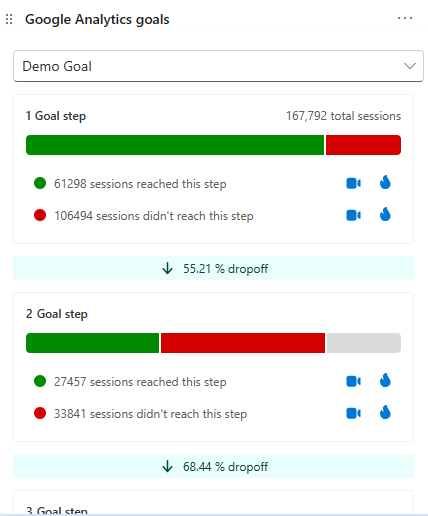Introducing the Blind Attractions: Comprehending What Google Analytics Goals Can not Gauge
In the realm of electronic analytics, Google Analytics stands as an effective tool for monitoring and assessing on-line individual interactions. Recognizing what Google Analytics objectives can not gauge is vital for getting a comprehensive sight of individual behavior and involvement.
User Actions on External Platforms
Understanding just how users connect on outside platforms is critical for enhancing online methods. External systems, such as social networks networks, referral web sites, and online discussion forums, play a significant duty in driving traffic to a firm's site. By evaluating customer habits on these systems, companies can acquire valuable insights right into the effectiveness of their marketing efforts and the choices of their target market.
One trick element of user habits on exterior platforms is the recommendation resource. By tracking where the users are coming from, organizations can identify which platforms are driving the most traffic to their internet site. This details can help business allocate their sources better, concentrating on the platforms that yield the most effective outcomes.

Offline Conversions and Interactions
Analyzing user behavior on external systems supplies beneficial understandings into online strategies; however, considering offline conversions and communications is just as essential for an extensive understanding of a company's overall efficiency. While Google Analytics stands out at tracking on the internet interactions, it falls short in capturing the complete consumer trip that commonly consists of offline touchpoints. Offline conversions, such as in-store acquisitions or phone questions, play a substantial duty in several services' success. Neglecting these interactions can result in an altered sight of the effectiveness of advertising campaigns and general service efficiency.

Acknowledgment Beyond Last Click
When delving right into the world of digital advertising analytics, it ends up being necessary to look past the solitary touchpoint of the last click for a more detailed understanding of attribution. While Google Analytics offers useful understandings right into user habits, depending only on last-click attribution can be restricting - what data is google analytics goals unable to track. Acknowledgment versions that go beyond the last click supply a much more nuanced sight of the customer journey, taking right into account all the touchpoints that lead to a conversion
Attribution beyond the last click enables online marketers to designate credit scores to numerous interactions along the conversion course, providing a clearer photo of the efficiency of different advertising channels. By exploring multi-touch acknowledgment versions such as direct, time decay, or position-based attribution, companies can better assign their marketing budget plans and maximize their strategies for optimal influence.
Recognizing the impact of each touchpoint in the conversion process is vital for making informed choices and taking full advantage of ROI. By accepting attribution past the last click, organizations can obtain much deeper understandings into customer actions and tailor their marketing initiatives better.
Cross-Device and Cross-Browser Monitoring

In a similar way, cross-browser tracking matches cross-device monitoring by recording customer behavior as they switch in between different internet internet browsers. Comprehending just how users engage with internet sites on various web browsers can assist marketing experts optimize their on the internet experiences to make certain consistency and performance across various systems.
Qualitative Information and User Intent
Comprehending user intent with qualitative information analysis is crucial for creating targeted digital marketing methods that resonate with the demands and choices of the target audience. Qualitative information gives insights right into the 'why' behind user activities, losing light on inspirations, feelings, and choices that measurable information alone can not record. By analyzing user feedback, remarks, and communications, marketing experts can uncover valuable information concerning customer intent, allowing them to customize their messaging, web content, and offerings to better align with what their target market is looking for.
Qualitative data also helps in recognizing the context in which individuals engage with a website or application. This contextual understanding allows online marketers to create even more relevant and personalized experiences, eventually driving higher involvement and conversion rates. By delving right into user intent via qualitative data evaluation, services can acquire a much deeper understanding of their target audience, leading to extra effective advertising and marketing techniques that meet individuals' needs and assumptions.
Conclusion
Finally, Google Analytics goals have important link restrictions in gauging individual actions on outside systems, offline conversions, attribution past last click, cross-device and cross-browser tracking, and qualitative information associated to customer intent. what data is google analytics goals unable to track. It is necessary for businesses to be conscious of these unseen areas in order to supplement their information evaluation with other devices and methods to obtain a more detailed understanding of their target market and enhance their total digital marketing methods
By analyzing individual actions on these platforms, services can obtain important understandings into the effectiveness of their advertising initiatives and the preferences of their target audience.
Evaluating individual actions on external platforms gives beneficial insights into on the internet techniques; nevertheless, taking into consideration offline conversions and interactions is equally essential for an extensive understanding of a business's general efficiency.In electronic marketing analytics, moving beyond last-click attribution to check out cross-device and cross-browser monitoring is essential for gaining a holistic understanding you can check here of individual communications across different platforms and gadgets. By evaluating user responses, remarks, and communications, marketing experts can reveal beneficial details concerning user intent, permitting them to customize their messaging, material, and offerings to better visit site align with what their target market is looking for.
By diving into user intent through qualitative information evaluation, services can get a deeper understanding of their target audience, leading to more reliable advertising and marketing methods that satisfy users' demands and assumptions.